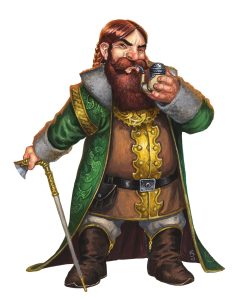
This article kicks off a series looking at the lineages in the Tales of the Valiant game, not as fantasy stereotypes but as if they’re alien species similar to what you’d find in science fiction.
The point of this is straightforward: your character’s lineage should be a cornerstone of deep roleplaying, not just a mechanism for gaining some bonuses you’d like to have. Elves, dwarves, smallfolk, and the crew aren’t just humans with pointy ears or lush beards. Like everyone, you and me included, they are products of their culture, their upbringing, and their genes, which are very different from one lineage to another: one might even say alien. They don’t think, act, or view the world the way humans do—and that’s a fascinating roleplaying challenge.
The Assumptions
Treating every lineage as if it’s “as varied as humans” suffers from three problematic assumptions.
First is the notion humans are the baseline. In a fantasy setting where humans are often late arrivals on the sentient beings stage, that’s a failure of imagination.
Second is that humans can do anything. That’s simply untrue. We can’t fly, we can’t see in the infrared or ultraviolet spectrums, and we can’t outrun a cheetah, just to name a few examples.
Third is that it encourages the mindset we’re trying to get away from—that choosing a lineage is all about getting a few juicy bonuses. Choosing a lineage is about who you are. By the end of this series, you’ll have a host of roleplaying reasons for choosing a lineage beyond the mechanical advantages it gives your build.
The traits ascribed to lineages in this series aren’t exhaustive or universal. You’re free and encouraged to devise your own cultural details for your character, using these as a guide. But make it different, thought-provoking, and a solid hook for a unique roleplaying experience. If you want your character to be another human, play a human.
We kick things off with a look at dwarves.
Dwarves
What sets dwarves apart from other player-character lineages? What cultural and genetic forces shape them into the creatures they are?
This article looks at dwarves with the typical, recommended Fireforge or Stone heritages. Some of what’s stated here won’t apply to dwarves with different heritages—and it might apply fully to nondwarf characters with the Fireforge or Stone heritage. In general, wherever we state “dwarf” in this article, we mean “typical Fireforge or Stone dwarf.”
So what makes a dwarf?
- Dwarves are short but sturdy and powerful.
- Dwarves live primarily underground or in remote, inaccessible regions.
- In their underground or isolated realm, they are constantly beset by other subterranean creatures that raid dwarven settlements and waylay small groups for slaves or slaughter.
- Everything dwarves create—their architecture, crafts, art, and runes—are angular and stolid.
Looking Up at the World
In all their dealings with humans, elves, and other outsiders, dwarves must look up to make eye contact. However, unlike some other short-statured creatures, dwarves aren’t bothered by size differences. They consider their short, powerful physique to be an advantage, not a disadvantage.
Dwarves are perfectly at home in low-ceilinged tunnels and claustrophobic dungeon passages. A low center of gravity is an advantage where there’s uncertain footing, such as uneven cavern floors. Taller, larger foes like trolls, ogres, and golems must bend down to the dwarves’ height to fight them, and dwarves can use tight spaces to great advantage in such battles. Far from causing feelings of inferiority, a dwarf’s stature is a source of strength and pride.
Living Deep Down
To surface dwellers, the subterranean realm is “the underworld.” It’s seen as cold, dark, dank, alien, and most of all, dangerous. It’s an unwelcoming world without warming sunlight or refreshing breezes.
Stone heritage dwarves grow up entirely underground. Fireforge dwarf communities often have aboveground and underground districts, and dwarves of both heritages spend long stretches of time in tunnels and mines.
To these dwarves, the underground realm is simply “the world.” Unlike the surface, it is predictable, reliable, unchanging, and eternal. No sunrise or sunset regulates work, no seasons mark the passage of years, no tornadoes demolish homes, no chilling snow smothers crops. Dwarves are comforted by this stolidity and see it as the way nature should be.
A secondary effect is that dwarves are largely unconcerned with tracking time in small units—which here refers to hours, days, weeks, months, and even years. They mark time by work shifts, by generations, and by the reigns of monarchs. They’re aware of seasons passing on the surface but unconcerned by them. In a world of stone, the march of time is measured by the growth of stalactites and stalagmites.
In the dwarves’ world, little changes unless they change it (barring natural disasters). This is perfect agency; dwarves are total masters of their environment. If a chamber needs a higher ceiling or an underground river needs rerouting, the only way it happens is by dwarves cutting stone with hammers and chisels. Once stone is cut, it’s cut forever. All the generations to come will see that work and judge it, so it had better be good. Permanence is important, and anything important is permanent.
Enemies All Around
The underworld is a uniquely dangerous realm. Most subterranean creatures and cultures are evil, territorial, and warlike. Dwarves are among the few non-evil creatures that carve large communities deep underground or in remote mountain ranges that are rich in mineral wealth and far from allies. As such, their communities are always beset by enemies with great bloodlust and few scruples. Dwarves and their families live under the constant threat of violence, abduction, and death.
Vigilance bordering on paranoia is a dwarf’s constant companion from childhood. Strangers should never be trusted until it’s certain they aren’t enemies, enemy spies or agents, or enemy sympathizers. When something unknown approaches a guardpost, shooting first may be the difference between living and dying—or being enslaved, eaten alive, or both—not just for the dwarves on guard but for everyone depending on them.
As the saying goes, you can take the dwarf out of the siege but you can never take the siege mentality out of the dwarf.
Angles, Angles Everywhere
Dwarven culture is steeped in angularity: straight lines, flat surfaces, and sharp angles. This is a dwarven aesthetic, but it’s also a practical issue. Straight lines and flat surfaces are a natural consequence of working stone with iron chisels. Curves and rounded surfaces are difficult to cut and prone to errors.
Just as language shapes thought, so do deep-seated cultural surroundings. Even when it’s intricate and decorative, dwarf-style architecture is angular, sharp, and blunt. The same goes for the runic writing of dwarves. Whether runes are used alphabetically or ideographically (to express discrete concepts in a single shape), they are always sharp, crisp, and harsh.
This enveloping bluntness—some might call it brutality—seeps into the dwarves’ subconscious and colors their perception and their expression. In thought, speech, and action, dwarves tend to be as brusque and no-nonsense as their chiseled architecture and sharp-angled runes. They can be humorous, poetic, romantic, etc., but even their humor and poetry is abrupt and sharp. This is simply the way they think after generations surrounded by nothing soft or curved.
Roleplaying Your Dwarf
Putting it all together, here are some cues to make roleplaying a Fireforge or Stone dwarf distinct from other lineages and heritages.
- Your short, thick stature is a great strength and a source of pride. Allow no one to make fun of it.
- Leave your mark on the world. Your years of life are limited, but your work and your deeds can endure. Even if people don’t remember your name, your accomplishments should be such that they’ll be seen and spoken of for generations. Legacy doesn’t just happen; you must strive for it.
- Keep your guard up and trust no one until they’ve earned it. You aren’t being paranoid if enemies really are all around—which they are.
- Speak the truth or say nothing. Never camouflage your meaning with flowery words or by talking around the point. Say what you mean and mean what you say, and respect others who do the same.
Dwarves who stick to those four rules can hold their heads high and command respect wherever they go.


These were really helpful and I think will help my players. I am eager to read more about others!
I love the emphasis on culture. This is truly what separates us and makes us different. Even in the real world where we’re all human, you’re going to have a different outlook on life if you grow up in or near a desert vs a swampy place. The USA east and west coast are just as different as the the north and south – even while having a greater US identity. So it makes so much sense to not to play a dwarf as a bearded, short human. But just as one has to make an effort to understand the life of someone of a different gender, ethnicity, orientation – I think articles like this one help us to realize what would make a dwarf see the world differently.
Finally, I know this is starting to get to be essay-length, but your post also demonstrates why good roleplay in TTRPGs is actually a social good (vs the panic of the 1980s). If you can make the effort to truly transform your thinking to, in this example, dwarf thinking, then you are shaping your mind to be able to understand the real life “other” and perhaps have more empathy towards them.